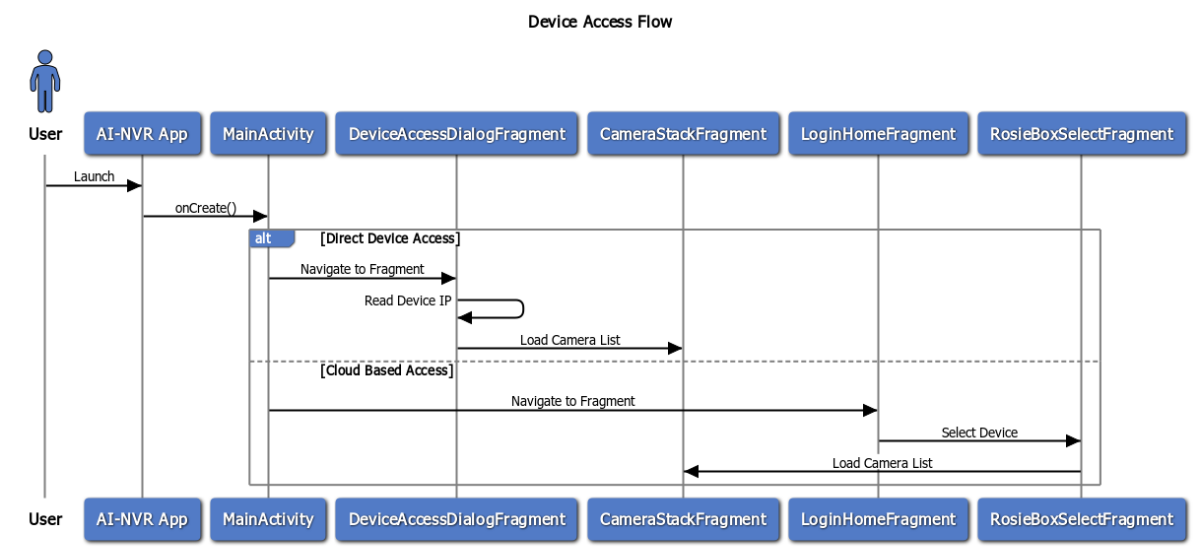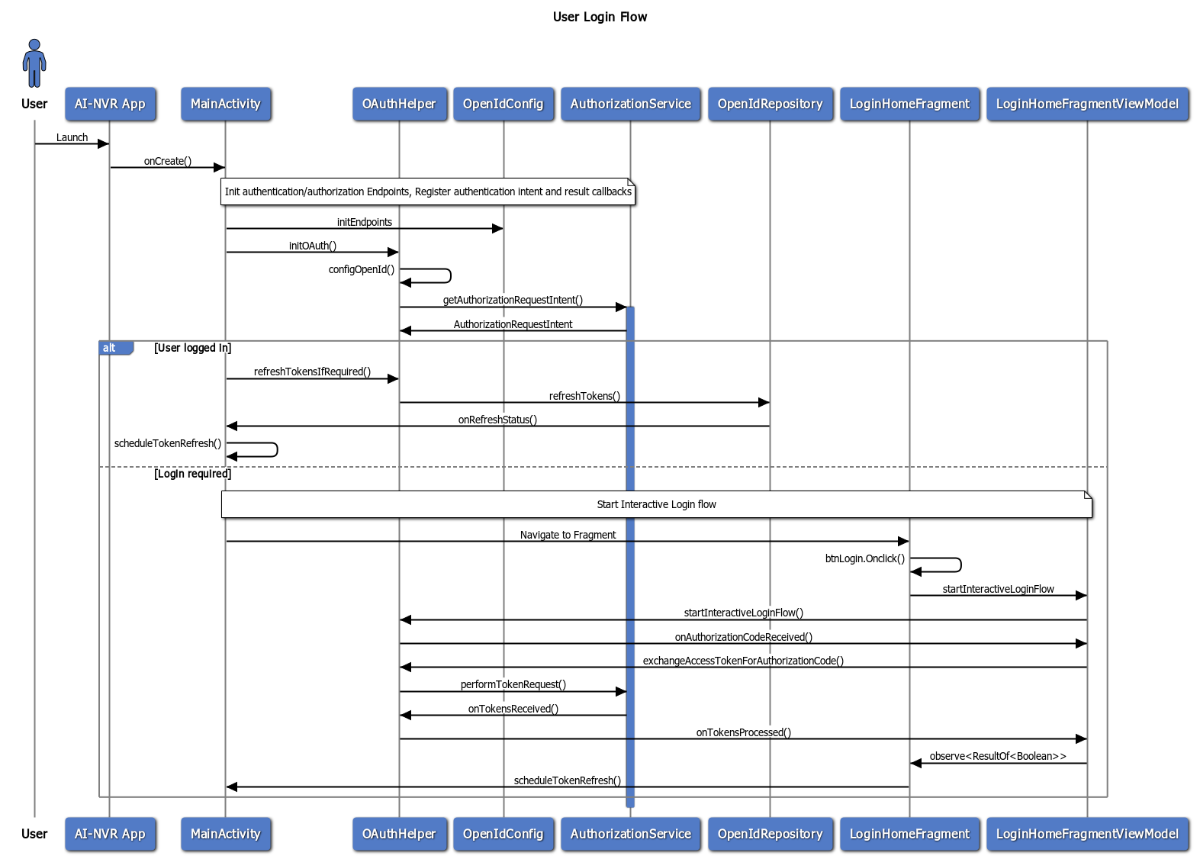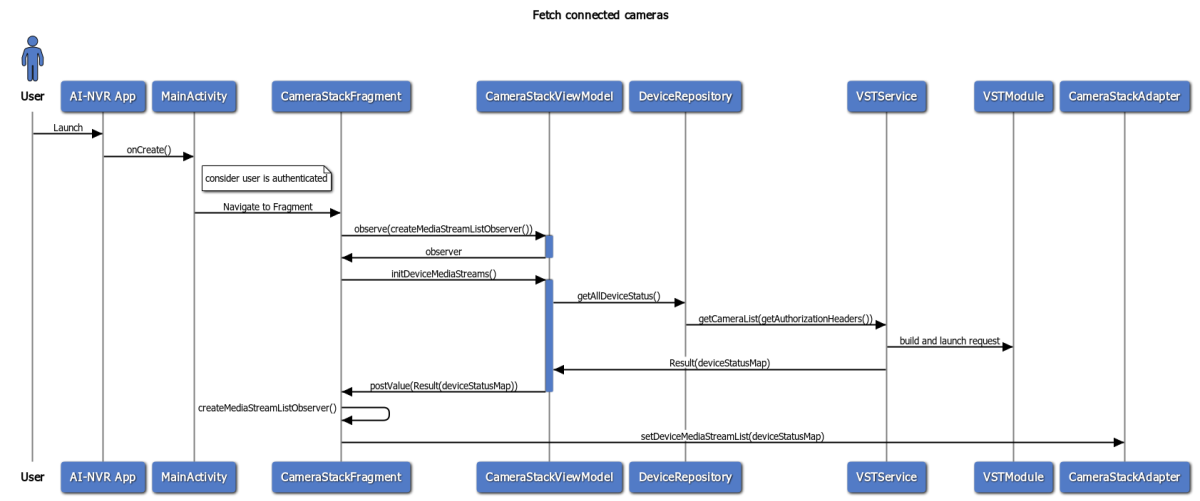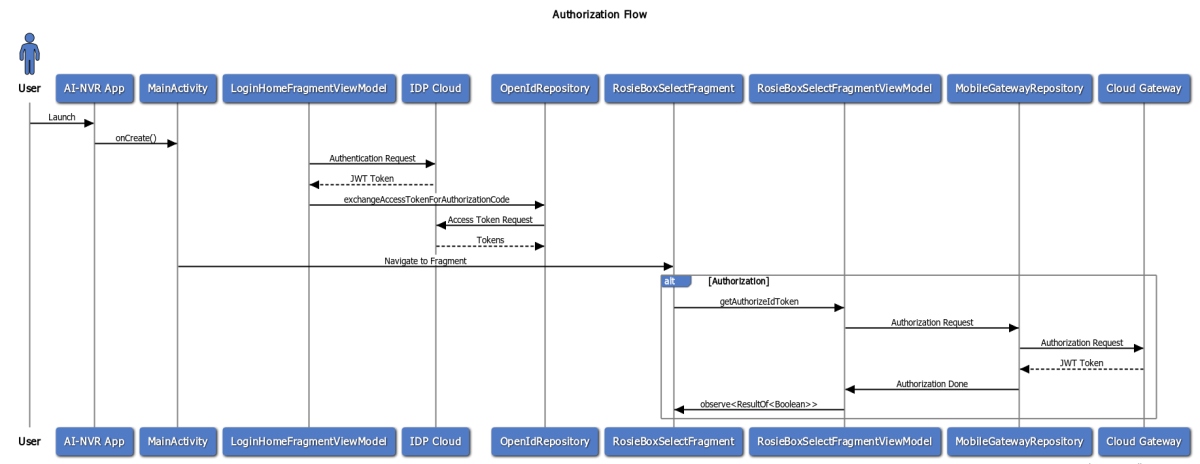AI-NVR Mobile Application Internals#
Device Access#
The mobile app has two launcher entry points. One is for direct access to the AI-NVR device where the device access will be based on <device ip>:port rather than through the cloud endpoint. The second entry point is for remote access to the device through the cloud. Remote access to the device through the cloud is not supported in this release.

User Login#
On app launch with cloud based access, the first thing the app does is checking for the logged-in user with a valid token. In the case of first launch or expired token - a login flow is launched as described below.

Communication with the AI-NVR device#
The app uses MVVM pattern.
Every request is initiated from UI classes (usually fragments or dialogs) while an Observer is configured to receive the response from the ViewModel and handle it.
The call to an API is routed to the module repository through the ViewModel of the corresponding module and executes the request using Retrofit. The response is delivered back to the ViewModel, which calls for the UI update using the LiveData and triggers the event on the Observer.
Video Storage Toolkit (VST)#
VST API is responsible for connected cameras, streams management, and actions. See the below list of VST APIs which are being used use in the app.
Sensor:
GET sensor/list: Get list of sensors/cameras with some details
GET sensor/streams: Get list of sensor streams information
Streams:
POST replay/stream/seek: Seek forward (+10s), seek backward (-10s), rewind and fast forward
POST replay/stream/pause: Pause the recorded stream playback
POST replay/stream/resume: Resume the recorded stream playback
POST replay/stream/stop: Stop WebRTC streaming
POST replay/stream/swap: Switch stream type from live to recorded
POST replay/stream/start: Start WebRTC streaming
GET replay/stream/status: Get stream error status and playback status like PLAYING, PAUSED, NOT PLAYING
GET replay/stream/stats: Get stream stats like frame rate, total encoded and decoded frames
GET replay/stream/query: Get stream last played timestamp and related metadata, if available
The following flow demonstrates the fetching of connected cameras.

Playing/Pausing a camera from the list is triggered by setClickListenerState() in CameraStackAdapter class, which overrides onRequestStreamState interface and eventually calls to a function from a CameraStackViewModel class. Every Media Player requests which changes the WebRTC player states (Play/Pause/Stop) is initiated from UI classes (usually fragments or dialogs) -> ViewModel -> RtcClient -> Service class -> Module which executing the request using Retrofit. The following flow demonstrates play of one of the streams from a CameraStackAdapter.

eMDAT APIs#
eMDAT API is responsible for managing gems - FOV (Field of View), Tripwire, and ROI (Region of Interest). It is also responsible for retrieving analytical data from gem data. See the below list of eMDAT API functions which are used in the app.
FOV:
GET metrics/occupancy/fov/histogram: List count of people in camera field of view
Tripwire:
GET metrics/tripwire/histogram: List trip event count and alerts
GET config/tripwire: List all tripwire configs
POST config/tripwire: Create tripwires
DELETE config/tripwire: Delete tripwires
GET config/tripwire/history: List historical tripwire configs
GET config/rule/alerts/tripwire: List tripwire alert rules
POST config/rule/alerts/tripwire: Create tripwire alert rules
DELETE config/rule/alerts/tripwire: Delete tripwire alert rule
GET config/rule/alerts/tripwire/history: List historical tripwire alert rule
ROI:
GET metrics/occupancy/roi/histogram: List roi count and alerts
GET config/roi: List all roi configs
POST config/roi: Create rois
DELETE config/roi: Delete ROI
GET config/roi/history: List historical roi configs
GET config/rule/alerts/roi: List roi alert rules
POST config/rule/alerts/roi: Create roi alert rules
DELETE config/rule/alerts/roi: Delete ROI alert rule
GET config/rule/alerts/roi/history: List historical roi alert rule
Alerts:
GET alerts: List all alerts
The following diagram demonstrates a simplified flow of selecting a tripwire and fetching occupancy data.

Enable/Disable real-time alerts#
These APIs on the reference cloud are responsible for enabling and disabling real-time alerts for an Jetson-mobile app cloud-based connection.
POST api/enable-notification: Enable real-time alerts.
POST api/disable-notification: Disable real-time alerts.
The following diagram demonstrates a simplified flow of enabling/disabling and receiving real-time alerts for both direct device and cloud-based access.

